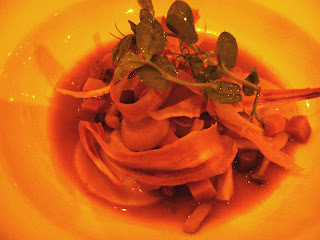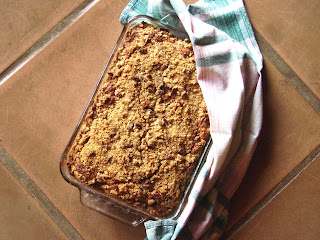I made my first batch of cookies in Singapore! And yes, I
will probably continue to get excited the first time I do every very normal
thing, only this time in Singapore. Anyway, the cookies were really just to
have a snack for Andrew to take to work; while we were in the hotel, we bought
granola bars that he ate for work-day snacks. They were good but I never like
how very sweet store-bought granola bars are, so I prefer making my own for
snacks.
Except then I made batch of granola on Sunday (first batch
of granola in Singapore!) and used most of my newly bought (first big shopping
trip for groceries in Singapore!) granola-bar-type ingredients for the actual
granola. But I did have an interesting new sugar (black sugar, which seems way
more exciting than brown sugar although it is in fact a similar colour to
treacle sugar, muscovado sugar, and other dark brown sugars), an interesting
new flour (very fine, pale yellow-ish whole-wheat flour; I’m not sure if it
actually is whole-wheat), and some baking staples like eggs and baking soda
(and here is another set of parentheses, just so I can say I have managed to
fit five sets into one two-sentence paragraph).
So I made up some sugar-laden cookies, meaning I could just
as well have bought more sugary granola bars for work snacks. But I’m glad I
didn’t because, much to my surprise, the cookies made with all the new-to-me ingredients,
eyeballed measurements and some unusual elements turned out to be some pretty
decent peanut cookies. I’m glad I paid attention when I made them; I will
definitely make them again, although this time for a treat instead of a snack.
For now, though, off to go get some more granola bar
ingredients. After I sort out a little kitchen disaster I just had (first kitchen disaster in Singapore!)
Whole-wheat olive oil
peanut cookies
Makes about 18
I’ve listed
alternative options for things like the fine whole-wheat flour and black sugar,
which should all work perfectly well. You could also substitute the peanut
butter with any other nut butter, and the olive oil with vegetable oil, but then you'd have to give the cookies a new name. Add-ins could work well
– chocolate chips, dried fruit, other nuts – although I liked the simplicity.
1 c fine whole-wheat flour (or use cake flour)
¼ tsp baking soda
½ tsp salt
½ c toasted sweet peanuts (another new-to-me ingredient; alternatively, use raw peanuts or very lightly salted roasted peanuts)
¼ c olive oil
¼ c peanut butter
½ c black sugar (or
any other dark, moist sugar such as treacle, muscovado, demerara, etc.)
¼ c caster sugar
1 egg
1 tsp vanilla extract
Preheat the oven to 175 C and grease a cookie sheet with a
little olive oil.
In a medium bowl, sift and mix flour, baking soda and salt.
Make a well in the centre and set aside.
In a small bowl, whisk olive oil, peanut butter, sugars, egg
and vanilla extract until well blended and frothy. Pour into the flour mixture
and mix with a wooden spoon until the mixture comes together into a firm dough.
Break off slightly-larger-than-walnut-sized chunks of dough
and roll them into balls. Place the balls spaced about three centimetres apart
on the cookie sheet and press each ball to flatten into a disk.
Slide the
cookies into the oven and bake for 8 to 12 minutes - less if you want softer cookies, more if you'd prefer them a little crisp. Remove from the oven and
cool for 5 minutes before lifting onto a wire rack to cool to room temperature.
These cookies kept well in a sealed container for one and a half days and then they were gone, so I have no further information on how long they might keep.


























